Rice and pasta are staples in most homes. My family has rice and pasta every week and my pantry is always stocked with both items.
The advantage of rice and pasta is that they are both versatile and very easy to cook with. Rice and pasta only require boiling water to be cooked. Their neutral taste also makes them ideal to pair with any protein and vegetable.
You can also use rice and pasta to make sweet dishes. Some cultures add sugar to rice to make a rice pudding. There is also a Portuguese dish called Aletria that uses pasta, sugar, cinnamon, and milk to make a delicious dessert.

Since my family regularly consumes both rice and pasta, I started wondering how these two foods compare to each other. Is one a healthier choice than the other or are they both healthy options?
Ingredients Comparison
There is a wide variety of rice and pasta on the grocery store shelves these days. For the sake of this article, though, I will be comparing regular, unenriched, long-grain white rice with regular, unenriched pasta made from semolina flour.
Semolina is flour made from durum wheat. Semolina is coarser and heavier than regular white flour but it also has more nutrients retained in it. The biggest disadvantage of semolina made from durum wheat is that it is highly glutinous.
The high gluten content makes it great for making pasta but not so great if you are gluten intolerant, have a gluten sensitivity, or have a wheat allergy. If you are gluten intolerant, you will need to stick with rice or look into gluten-free pasta.
Rice vs. Pasta Nutritional Comparison
For this comparison, I will be examining rice and pasta side-by-side. I want to examine everything from calories, carbs, fat, sodium, vitamins, and minerals, and even flavor and texture.
Each comparison will be broken down into categories and will have a winner. The serving size for rice and pasta varies so, in order to keep the comparison fair and accurate, I will be doing a weight-for-weight comparison of 100 grams each.
By the end of the article you, too, will be able to see how rice and pasta compare and if they are healthy options for your family. Let’s get started!
Best for Calorie Content
The first category on every nutrition label is calorie content so that is where I am beginning this comparison. Calories are often the first thing people start cutting when they are trying to lose or maintain weight.
Calories in themself are not bad. Calories are energy. Our bodies need energy to live. The problem comes in when we consume more calories than we burn.
There are guidelines that help both men and women know how many calories a day they need to consume, based on their age and activity level. You can even find calorie calculators online to help you figure out what your individual need is.
Rice and pasta are both high in calories but rice has slightly fewer calories per serving than pasta. A 100-gram serving of rice has 359 calories and pasta has 371 grams. If you are calorie-conscious, rice is the better choice for you.
|
Food Type |
Calories Per 100g |
|
Rice (white, unenriched) |
359 kcal |
|
Pasta (unenriched) |
371 kcal |
Best for Carbs & Sugar Content
Rice and pasta are both high in carbs. This makes either one ideal for the days you need carb-load before a long run or a strenuous day of exercising.
I am neither a runner nor an athletic person in any way, but I do have a busy life that requires me to have the energy I need to get everything done. Adding too many carbs to my diet causes me to feel tired and sluggish – not to mention the effect it has on my waistline.
If you are like me and try to limit your carb intake, pasta is the better choice. A 100-gram serving of rice has 80 grams of carbs but pasta has 74 grams.
|
Food Type |
Calories Per 100g Serving |
|
Rice (white, unenriched) |
80.3g |
|
Pasta (unenriched) |
74.7g |
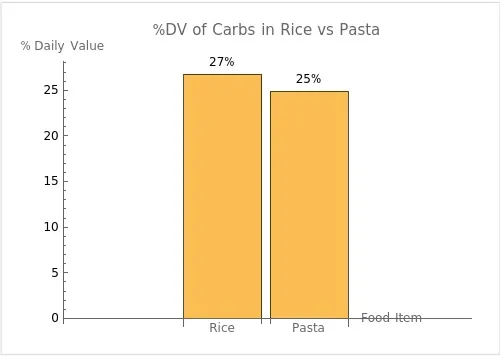
Best for Protein Content
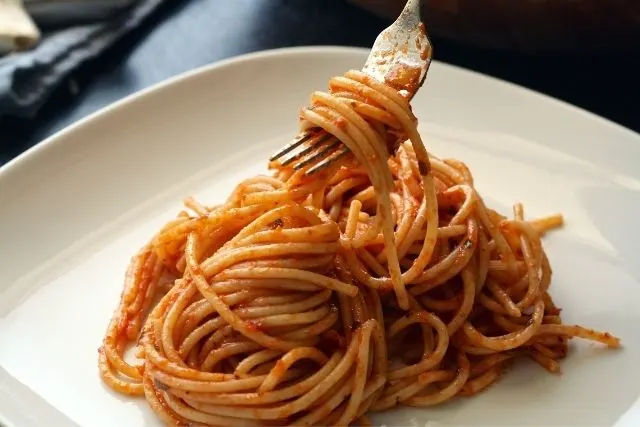
Protein is something I try very hard to make sure my family has at every meal. Protein is crucial when our kids are little, helping them develop strong bones and muscles. But protein is also very important as we age.
Protein helps our muscles recover from exercise, illness, or injury. It also improves mental clarity and fatigue, even boosting our memory power. Protein is also important for us women who are getting older and need to make sure our bones are strong and healthy.
Rice has a lot of protein per serving but one serving of pasta has almost double the amount of protein found in rice. You can, of course, boost the protein content of rice by adding any protein of your choice but for the sake of this comparison, pasta is the winner.
My family loves to have rice with grilled fish. I also like to add two egg yolks to cooked rice to increase the protein content – and flavor of the rice. The yolks give the rice a creamy texture as well. It pairs well with chicken or a bowl of fried rice with vegetables.
|
Food Type |
Protein Per 100g Serving |
|
Rice (white, unenriched) |
7.04g |
|
Pasta (unenriched) |
13g |
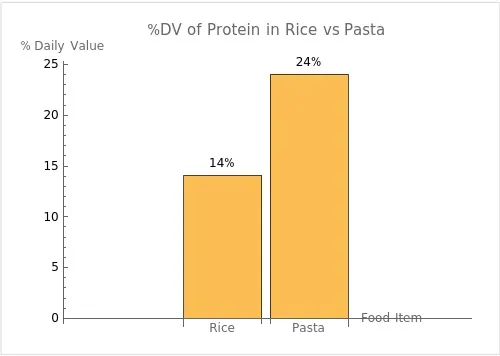
Best for Fat Content
One of the reasons why rice and pasta are so popular, aside from being so easy to cook, is they are both low in fat. There is only a slight difference in the amount of fat found in rice and pasta.
A serving of rice has 1 gram of fat compared to almost 2 grams found in pasta. If you are someone who closely monitors their fat intake, rice is the better choice for you.
Keep in mind that you will affect the final fat content if you add oil to your pasta or pair the pasta with a high-fat protein or sauce.
|
Food Type |
Fat Content Per 100g Serving |
|
Rice (white, unenriched) |
1.03g |
|
Pasta (unenriched) |
1.51g |
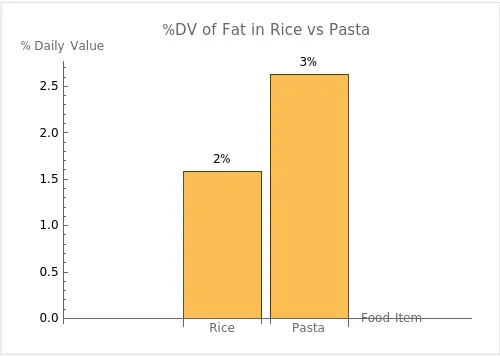
Best for Sodium/Salt Content
Sodium is another area that requires monitoring. Consuming too much sodium can have adverse health effects from high blood pressure to kidney issues. Rice itself is sodium free but pasta is not. Pasta has 6g of sodium per serving.
It’s important to keep in mind how much sodium pasta naturally has because we often add salt to the water when boiling pasta. This will significantly increase the sodium content, along with any other food or sauces it is paired with.
|
Food Type |
Sodium/Salt Per 100g Serving |
|
Rice (white, unenriched) |
0 |
|
Pasta (unenriched) |
6g |
Best for Vitamins/Minerals
Rice and pasta both have a variety of vitamins and minerals and are healthy options but pasta has much higher amounts of each vitamin and mineral. Pasta has higher amounts of calcium, potassium, and phosphorus.
The table below highlights a few examples of the nutrients found in rice and pasta. If you are looking for a specific vitamin or mineral, you can visit the USDA website for a more comprehensive list.
|
Vitamins and Minerals |
Rice (Per 100g Serving) |
Pasta (Per 100g Serving) |
|
Calcium |
4 mg |
21 mg |
|
Iron |
0.14 mg |
1.3 mg |
|
Magnesium |
26.5 mg |
53 mg |
|
Phosphorous |
108 mg |
189 mg |
|
Potassium |
82 mg |
223 mg |
|
Zinc |
1.35mg |
1.41 mg |
|
Niacin |
1.43 mg |
1.7 mg |
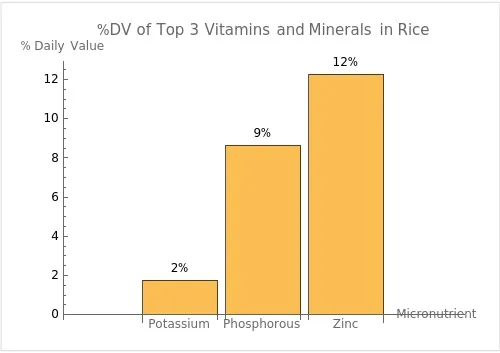
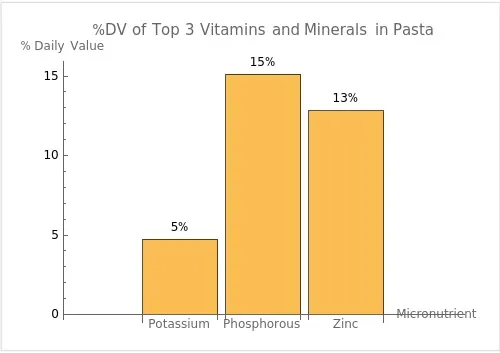
Regarding the recommended daily intakes:
- Potassium: Approximately 4,700 mg/day
- Phosphorous: Approximately 700-1,250 mg/day (varies based on age and other factors)
- Zinc: Approximately 8-11 mg/day (varies based on gender and other factors)
Best for Flavor/Texture
Rice and pasta both have very neutral flavors, which makes them so easy to incorporate with other foods. Deciding which one tastes better will come down to your individual taste preference and which one you prefer to use in your family’s menu.
When it comes to the texture of rice and pasta, deciding who the winner is will depend on how you like your rice and pasta cooked. My family likes rice to be cooked with a slight crunch to it, similar to how you cook pasta until it’s al dente. A mushier texture of the rice is great for making rice pudding.
Best for Price
Rice and pasta are comparable when it comes to price. They are both very affordable and are available anywhere food items are sold. The price will undoubtedly vary if you buy either one in bulk or on sale at your local grocer.
Overall Winner
Rice and pasta are both healthy options. Rice is low in calories and fat, free of sugar and salt, and has a variety of vitamins and minerals. Pasta is low in carbs and fat, is high in protein, and has a high amount of calcium, magnesium, phosphorus, and potassium.
When you look at each category side-by-side, you can see there is a winner – rice. But ultimately the winner will depend on which one you feel is right for you and your family.
Comparison Category |
Rice vs. Pasta |
|
Best for Calorie Content |
Rice |
|
Best for Carbohydrate Content |
Pasta |
|
Best for Sugar Content |
Rice |
|
Best for Protein Content |
Pasta |
|
Best for Fat |
Rice |
|
Best for Sodium/Salt |
Rice |
|
Best for Vitamins/Minerals |
Pasta |
|
Best for Price |
Both are winners |
Overall Winner |
Rice |
